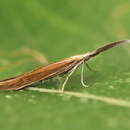fr
noms dans le fil d’Ariane


Coleophora wockeella is a moth of the family Coleophoridae. It is found from Latvia to the Iberian Peninsula, Italy and Albania and from Great Britain to southern Russia.
The wingspan is about 20 mm. Adults are ochreous with several whitish streaks on the forewing and distinctively thickened bases to the antennae. Adults are on wing from June to July in western Europe.[2]
The larvae feed on betony (Stachys officinalis). They create a dark brown, bivalved, composite leaf case of about 10 mm long and composed of six to eight ringlets. The mouth angle is very sharp, causing the case to lie almost flat on the leaf.[3] Larvae can be found from autumn to mid-May.
The species was named after the German entomologist Maximilian Ferdinand Wocke.
Coleophora wockeella is a moth of the family Coleophoridae. It is found from Latvia to the Iberian Peninsula, Italy and Albania and from Great Britain to southern Russia.
 Mined leaf of Betonica officinalis with a larva-case attached
Mined leaf of Betonica officinalis with a larva-case attached The wingspan is about 20 mm. Adults are ochreous with several whitish streaks on the forewing and distinctively thickened bases to the antennae. Adults are on wing from June to July in western Europe.
The larvae feed on betony (Stachys officinalis). They create a dark brown, bivalved, composite leaf case of about 10 mm long and composed of six to eight ringlets. The mouth angle is very sharp, causing the case to lie almost flat on the leaf. Larvae can be found from autumn to mid-May.